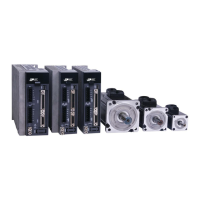168
SV200 AC Servo Drive User Manual
920-0096H
2/6/2018
10.3 Fine tuning
Depending on the mechanical system characteristics and the servo motor used, the following parameters are available and may need to
be adjusted to improve system performance:
● Global gain (KP)
● Position loop gain (KF)
● Derivative gain (KD)
● Damping gain (KV)
● Integrator Gain (KI)
● Inertia feed forward gain constant (KK)
● Derivative lter gain (KE)
● PID lters (KC)
This step should be completed only after the Auto-Tune function has been done and if improvements are needed for the tuning. A
sample move can be defined and run once for each click of the Start button or continuously to facilitate real-time dynamic tuning (i.e.
adjustment of gains and filter settings while the motor is moving).
Among the parameters listed above, changes to Global gain (KP), Derivative filter gain (KE) and PID filter (KC) are NOT
recommended after the system has been configured with the Auto-Tune function. Therefore, parameter adjustments during the fine
tuning phase should be limited to Position loop gain (KF), Derivative gain (KD), Damping gain (KV), Integrator Gain (KI), Inertia
feed forward gain constant (KK). See details below.
However, if you experience mechanical resonance or hear high-pitched squealing noises, you can lower the PID Output Filter below the
natural frequency of your system so that the PID output does not excite the resonance.
If you have a large inertial load, you’ll probably find that you (or the auto-tuner) need to set the gain parameters high, especially PP
and KI, to get good response. Then you will want to increase the damping to prevent ringing. Now the system is likely to be so tight
that if you have a springy, all metal coupling it may “buzz” or “squawk”. Reducing the frequency of the derivative filter can remove this
objectionable sound.
10.3.1 Position loop gain (KF)
This parameter is the primary gain term for minimizing the position error. Increasing KF will increase stiffness and reduce settling time.
However, it might cause vibration if increased too much. This is simplest part of the PID loop; the drive will apply current to the motor
in direct proportion to the error. Because the current controls the torque output from the motor, increasing this gain will increase the
magnitude of torque in direct proportion to the position error. Here’s an example: if the motor were standing still, and you suddenly
turned the shaft by hand, you’d want the drive to increase the motor current so that it goes back into position. The further you disturb
the motor from its target position, the more the torque will increase.

